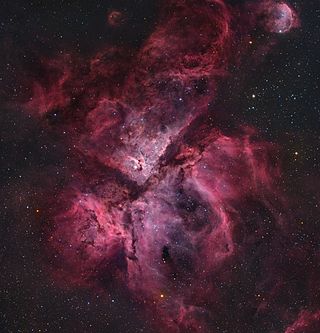
The Carina Nebula or Eta Carinae Nebula is a large, complex area of bright and dark nebulosity in the constellation Carina, located in the Carina–Sagittarius Arm of the Milky Way galaxy. The nebula is approximately 8,500 light-years (2,600 pc) from Earth.

Messier 52 or M52, also known as NGC 7654, is an open cluster of stars in the highly northern constellation of Cassiopeia. It was discovered by Charles Messier on 1774. It can be seen from Earth under a good night sky with binoculars. The brightness of the cluster is influenced by extinction, which is stronger in the southern half. Its metallicity is somewhat below that of the Sun, and is estimated to be [Fe/H] = −0.05 ± 0.01.

NGC 6709 is an open cluster of stars in the equatorial constellation of Aquila, some 5° to the southwest of the star Zeta Aquilae. It is situated toward the center of the galaxy at a distance of 3,510 light-years.
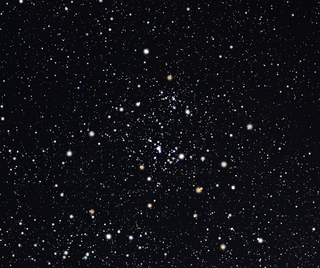
NGC 6755 is an open cluster of stars in the equatorial constellation of Aquila, positioned about 3° to the east of the star Delta Aquilae. It was discovered by the Anglo-German astronomer William Herschel on July 30, 1785. Located at a distance of 8,060 light years from the Sun, it lies 30′ to the northeast of NGC 6755, with the pair forming a visual double cluster. However, they probably do not form a binary cluster system since they have different ages and are too distant from each other.

In astronomy, the Collinder catalogue is a catalogue of 471 open clusters by Swedish astronomer Per Collinder. It was published in 1931 as an appendix to Collinder's paper On structural properties of open galactic clusters and their spatial distribution. Catalogue objects are denoted by Collinder, e.g. "Collinder 399". Dated prefixes include as Col + catalogue number, or Cr + catalogue number, e.g. "Cr 399".

NGC 2281 is an open cluster of stars in the northern constellation of Auriga. It was discovered by English astronomer William Herschel on March 4, 1788 and described as a, "cluster of coarsely scattered pretty [bright] stars, pretty rich". The Trumpler class for NGC 2281 is I3p, indicating a poor (p) but compact (I) grouping with a wide range of brightness (3). It is located at a distance of approximately 1,720 ly from the Sun and is 630–661 million years old.

NGC 637 is an open cluster of stars in the northern constellation of Cassiopeia, positioned about 1.5° to the WNW of the star Epsilon Cassiopeiae. The cluster was discovered on 9 November 1787 by German-born English astronomer William Herschel. It is located in the Perseus Arm of the Milky Way, at a distance of approximately 7.045 kilolight-years from the Sun. The cluster is small but compact, and is readily visible in a small telescope.
Ruprecht 147 or NGC 6774 is a dispersed star cluster in the Milky Way galaxy. It is about 1,000 light years away, which is close to Earth in comparison with other such clusters. In late summer, it can be seen with binoculars in the constellation of Sagittarius. The stars, bound by gravity, are about 2.5 to 3.25 billion years old. The cluster, discovered in 1830 by John Herschel, was sometimes thought to be an asterism due to its sparseness and location against the background of the richest part of the Milky Way, and also since the brightest stars in this old cluster perished long ago. In 1966 the Czech astronomer Jaroslav Ruprecht classified it as a type III 2 m open cluster under the Trumpler scheme. It received otherwise little attention until 2012, when it was identified as a potentially important reference gauge for stellar and Galactic astrophysics research, particularly the research of Sun-like stars. Additionally, Ruprecht 147 has five detached eclipsing binary that are relatively bright, and thus easy to observe.
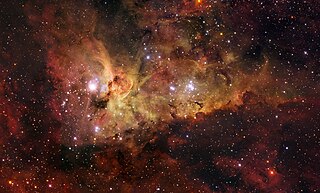
Trumpler 16 is a massive open cluster that is home to some of the most luminous stars in the Milky Way galaxy. It is situated within the Carina Nebula complex in the Carina–Sagittarius Arm, located approximately 9,270 ly (2,842 pc) from Earth. The cluster has one star visible to the naked eye from the tropics southward, Eta Carinae.
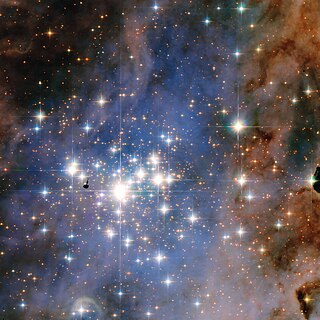
Trumpler 14 is an open cluster with a diameter of six light-years (1.8 pc), located within the inner regions of the Carina Nebula, approximately 8,980 light-years (2,753 pc) from Earth. Together with the nearby Trumpler 16, they are the main clusters of the Carina OB1 stellar association, which is the largest association in the Carina Nebula, although Trumpler 14 is not as massive or as large as Trumpler 16.
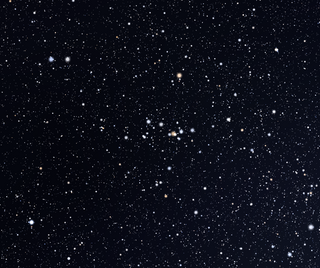
Trumpler 2 is an open cluster located in the constellation Perseus. It is approximately 2000 light-years from Earth, placing its position within the Perseus Arm of the Milky Way Galaxy. Although at this large distance, it can be seen with the naked eye, at magnitude 6.
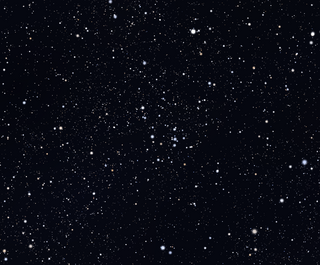
Trumpler 3 is an open cluster located in the constellation Cassiopeia. It has the visual magnitude of 7 and is one of the most famous star clusters in the Trumpler catalogue.

Trumpler 15 is an open cluster in the constellation Carina that lies on the outskirts of the Carina Nebula. Estimated ages of the stars in Trumpler 15 suggest that the cluster is slightly older than its sibling clusters Trumpler 14 and 16.
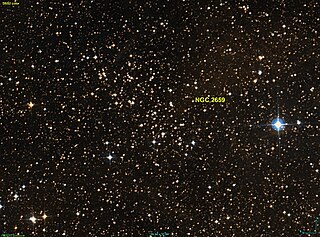
NGC 2659 is an open cluster in the constellation Vela. It was discovered by John Herschel on 3 February, 1835. It is of Trumpler class III3m. It is a young cluster, with age nearly 8 million years. The core of the cluster is 1.93 parsec across and the total radius is 3.6 pc. The total number of stars that belong to the cluster is estimated to be 1,801 ± 608 stars and the total mass 857 ± 237 M☉. Among its members, one is a Be star, with four more possible Be stars.
NGC 5662 is an open cluster in the constellation Centaurus. It was discovered by Nicolas Louis de Lacaille on May 17, 1752 from South Africa. James Dunlop observed it on July 10, 1826 from Parramatta, Australia and added it to his catalog as No. 342.

NGC 3228 is an open cluster in Vela. It was discovered by Nicolas Louis de Lacaille in 1751–1752, while he was in South Africa and catalogued it as Lac II.7. It is small but bright and can be observed easily with binoculars in sufficiently dark skies.

NGC 5617 is an open cluster in the constellation Centaurus. NGC 5617 forms a binary open cluster with Trumpler 22. It lies one degree west-northwest of Alpha Centauri.
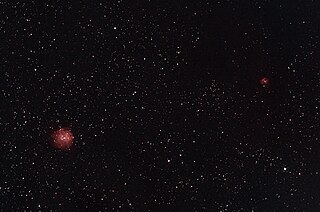
NGC 1624, also known as Sh2-212 in the Sharpless catalog, is a very young open cluster in the constellation Perseus inside an emission nebula. It was discovered by German-British astronomer William Herschel in 1790. NGC 1624 is about 20,000 ly from Earth, and latest estimates give it an age of less than 4 million years. Its apparent magnitude is 11.8, and apparent diameter is about 3.0 arc minutes. Its celestial location is right ascension (α) 04h 40m 36.0s and declination (δ) +50° 27′ 42″. It is potentially an area of massive star formation.

Trumpler 27 is a possible open cluster in the southern constellation Scorpius. If it exists, it is a few thousand light-years away from the Sun, with estimates ranging from 3,900 light-years to 6,800 light-years The name refers to Robert Julius Trumpler's catalog of open clusters, published in 1930.

Trumpler 27-1 is a red supergiant star that is a member of the massive, possible open cluster Trumpler-27, where a blue giant star, a yellow supergiant star, and two Wolf–Rayet stars are also located.


















